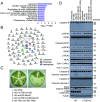A bacterial effector manipulates host lysosomal protease activity-dependent plasticity in cell death modalities to facilitate infection
- PMID: 39964716
- PMCID: PMC11874418
- DOI: 10.1073/pnas.2406715122
A bacterial effector manipulates host lysosomal protease activity-dependent plasticity in cell death modalities to facilitate infection
Abstract
Crosstalk between cell death programs confers appropriate host anti-infection immune responses, but how pathogens co-opt host molecular switches of cell death pathways to reprogram cell death modalities for facilitating infection remains largely unexplored. Here, we identify mammalian cell entry 3C (Mce3C) as a pathogenic cell death regulator secreted by Mycobacterium tuberculosis (Mtb), which causes tuberculosis featured with lung inflammation and necrosis. Mce3C binds host cathepsin B (CTSB), a noncaspase protease acting as a lysosome-derived molecular determinant of cell death modalities, to inhibit its protease activity toward BH3-interacting domain death agonist (BID) and receptor-interacting protein kinase 1 (RIPK1), thereby preventing the production of proapoptotic truncated BID (tBID) while maintaining the abundance of pronecroptotic RIPK1. Disrupting the Mce3C-CTSB interaction promotes host apoptosis while suppressing necroptosis with attenuated Mtb survival and mitigated lung immunopathology in mice. Thus, pathogens manipulate host lysosomal protease activity-dependent plasticity in cell death modalities to promote infection and pathogenicity.
Keywords: Mycobacterium tuberculosis; RIPK1; cathepsin B; mammalian cell entry 3C; programmed cell death.
Conflict of interest statement
Competing interests statement:The authors declare no competing interest.
Figures






References
-
- Schaible U. E., et al. , Apoptosis facilitates antigen presentation to T lymphocytes through MHC-I and CD1 in tuberculosis. Nat. Med. 9, 1039–1046 (2003). - PubMed
-
- Stutz M. D., et al. , Macrophage and neutrophil death programs differentially confer resistance to tuberculosis. Immunity 54, 1758–1771.e7 (2021). - PubMed
MeSH terms
Substances
Grants and funding
- 2022YFC2302900 and 2021YFA1300200/MOST | National Key Research and Development Program of China (NKPs)
- 82330069 81825014 and 31830003/MOST | National Natural Science Foundation of China (NSFC)
- 82171744 and 82472296/MOST | National Natural Science Foundation of China (NSFC)
- 82022041/MOST | National Natural Science Foundation of China (NSFC)
- XDB29020000/Strategic Priority Research Program of the Chinese Academy of Sciences
LinkOut - more resources
Full Text Sources
Other Literature Sources
Miscellaneous

